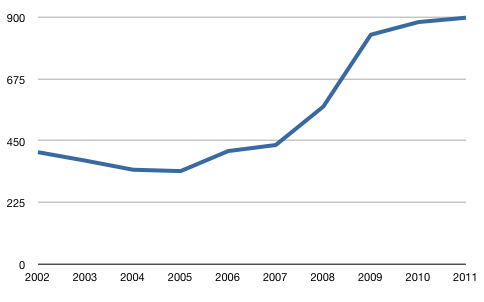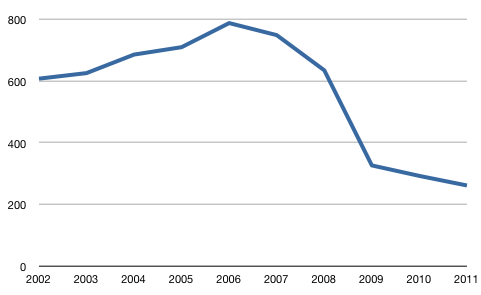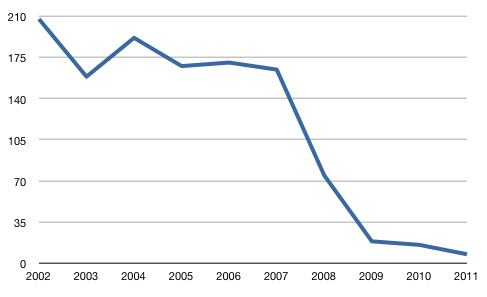Ryan Chittum has taken a look at the length of the stories on the front page of the WSJ.
Here’s what’s happened to the number of stories under 1,500 words:

Here’s the stories over 1,500 words:

And here’s the stories over 2,500 words:

Ryan is dismayed at these trends. “Without going long,” he writes, “it’s hard to achieve greatness”:
Certainly, the Journal still does lots of top-flight work, and most stories don’t need 2,500 words. But many do, and how does going short as a policy help readers understand the really important stuff like systemic problems, corporate misbehavior, business innovation, or sweeping economic change?
I, on the other hand, am much more sympathetic to what Murdoch is doing here. WSJ readers are busy: they don’t have time to wade through lots of overstuffed stories in the morning. They want to know what’s going on, and why, and they want their news-delivery mechanism to be as efficient as possible.
If you look at the chart of stories over 1,500 words, it peaked at 800 per year in 2006. That’s more than 2.5 such stories per day, every day including Saturdays. And that’s just on the front page! If you look at the paper as a whole, the 1,500-word stories were appearing at a pace of six per day before Murdoch came along and brought some sense to proceedings.
I read long business and finance stories for a living—that’s my job—and I don’t read six per day, let alone six per day from a single publication. The job of the WSJ is not to overload its readers with many hours’ worth of reading every day. And the current pace, of roughly one long-form front-page story per day, seems much more reasonable to me. (Most readers, of course, won’t even read that—but at least they won’t be completely overwhelmed.)
At the same time, it’s great that the WSJ is putting lots of important information on its front page in sub-1,500-word form—on top of the “What’s News” briefs. As a news consumer, I don’t even want anything nearly that long—I’m looking to get what I need within a few hundred words at most. US newspaper stories have a lot of water weight, and nearly all of them could stand to lose a few pounds.
And what of the dramatic fall-off in the really long-form stuff, over 2,500 words? Up until 2007, those managed to make the front page roughly every other day. Then they all but disappeared, and you’ll find maybe one a month at this point.
I can easily see why that should be the case. Very long stories are often highly self-indulgent, and they take a huge amount of time, effort, and money to put together. Sometimes, they’re incredibly important, and well worth both writing and reading. Often, however, they seem to be aimed at other journalists more than at the WSJ’s core business audience—most of which simply doesn’t have the time to read such things. In a good news organization, I think, the bar should be high before any such story is inflicted on millions of blameless readers. And keeping the output of long-form stories low is one great way of doing that.
The Columbia Journalism Review is naturally going to want to encourage “greatness” in American newspapers, and for decades now “greatness” in journalism has been synonymous with Very Long Stories. But I don’t think, frankly, that the WSJ’s readers have any particular interest in getting a serving of greatness alongside their breakfast cereal in the morning. They’re much more interested in news. And that, to its credit, is what the WSJ is giving them.
Felix Salmon is a financial writer, editor, and podcaster. A former finance blogger for Reuters and Condé Nast Portfolio, his work can be found at publications including Slate and Wired, as well as his own Substack newsletter.
